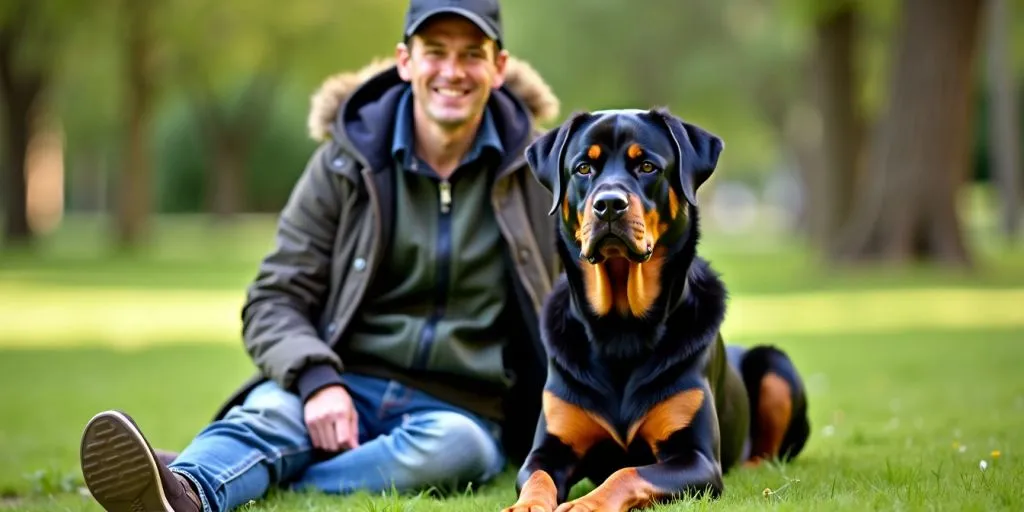Rottweiler’s aggression toward strangers is known for their dependability and quality, but they can sometimes appear hostile towards outsiders. Understanding the reasons behind this behavior is vital for any Rottweiler proprietor. This article will investigate successful methodologies to oversee and diminish forceful propensities in Rottweilers, guaranteeing a more secure environment for the puppy and those around them.
Key Takeaways
- Recognize common triggers that lead to animosity in Rottweilers.
- Utilize positive support to empower great behavior.
- Socialize your Rottweiler early to anticipate fear-based hostility.
- Remain calm and composed amid forceful episodes to maintain a strategic distance from heightening the circumstances.
- Look for proficient offer assistance on the off chance that forceful behavior holds on despite preparing endeavors.
Understanding Rottweiler Animosity Towards Outsiders
Rottweilers can appear hostile towards outsiders for different reasons. Understanding these triggers is basic for viable administration. Here are a few common triggers of hostility:
- Fear: A Rottweiler may feel debilitated by new individuals.
- Regional instinctual: They might see outsiders as interlopers in their space.
- Defensive behavior: Rottweilers frequently feel they have to be secure in their family.
Common Triggers of Hostility
Rottweilers are attentive pooches. They may not respond quickly but will appear with signs of inconvenience, some sometimes recently heightening to hostility.
Signs of Forceful Behavior
Recognizing the signs of hostility early can offer assistance in anticipating episodes. Explore for:
- Moo snarling sounds
- Gazing or hardened body pose.
- Appearing teeth or snapping
It’s important to watch your Rottweiler’s body dialect to get their sentiments. Overlooking these signs can lead to perilous circumstances.
The Part of Hereditary Qualities and Environment
Hereditary qualities play a portion in Rottweiler’s behavior, but the environment and preparation are similarly vital. A well-socialized Rottweiler is less likely to appear animosity. Early socialization is key to adjusting their protective instincts with neighborly behavior towards outsiders. By uncovering your Rottweiler to different individuals and circumstances, you’ll offer assistance to them to create a well-adjusted grown-up dog.
Socialization Tips for Rottweiler’s
Early Socialization Hones
Socializing your Rottweiler early is significant. Beginning when they were puppies to assist them ended up well-adjusted grown-ups. Here are a few successful ones:
- Uncover them in different situations: Take your puppy to parks, stores, and active lanes.
- Present them to diverse individuals: Let them meet individuals of all ages, sizes, and appearances.
- Energize positive intuition: Remunerate your pooch for calm behavior around unused encounters.
Presenting Your Rottweiler to Modern Situations
When presenting your Rottweiler to unused places, keep these tips on the intellect:
- Take it moderately: Gradually expose them to unused sights and sounds.
- Utilize treaties: Remunerate them for calm behavior in new settings.
- Remain calm: Your canine can sense your feelings, so stay loose.
Overseeing Intuitive with Other Mutts and Individuals
Overseeing how your Rottweiler interacts with others is key to anticipating animosity. Here it shows:
- Administer everything intuitive: Continuously keep an eye on your puppy when assembling unused mutts or individuals.
- Instruct fundamental commands: Commands like “Sit” and “Remain” can help control their behavior.
- Remunerate great behavior: Commend your dog when they behave well around others.
Socialization may be a travel, not a race. Take your time and be persistent together with your Rottweiler as they learn to explore the world around them.
By taking after these tips, you’ll offer assistance to your Rottweiler to be an inviting and well-socialized companion. Keep in mind that the more positive encounters they have, the less likely they are to appear hostile toward outsiders.
Dealing with Forceful Occurrences Securely

When managing forceful behavior in Rottweilers, it’s vital to act rapidly and calmly. Remaining calm can offer assistance to avoid the circumstances from rising. Here are a few key steps to take after:
Perusing CanineBody Dialect
Search for signs of push, such as snarling, hardened pose, or raised temper.
- Get it that these signals are notices; regard your dog’s space.
- Recognize that overlooking these signs can lead to more genuine animosity.
- Steps to De-escalate Forceful Behavior
- Explore your pooch from the circumstance promptly to anticipate any hurt.
- Utilize calming procedures, such as talking delicately or advertising treats.
- Dodge coordinates eye contact, as this can be seen as a risk.
- When to Look for Proficient Offer Assistance
- In case your Rottweiler frequently shows aggression, it may be time allude to”>to allude to a proficient coach.
Hunt for trainers who utilize positive fortification strategies.
Custom veterinary check-ups can also offer assistance in distinguishing any basic well-being issues that may contribute to forceful behavior.
Managing aggressive behavior is fundamental to the security of everybody included. By understanding your dog’s signals and acting appropriately, you’ll offer assistance to make a more secure environment for both your pet and those around you. Keep in mind that the duty rests with you to guarantee that your puppy is well-managed and prepared.
Devices and Assets for Overseeing Hostility
Suggested Preparing Hardware
- Gags: Valuable for security amid preparations and strolls.
- Chains: A strong chain makes a difference in keeping up control.
- Visual Prompts: Things like “disregard me” patches can flag to others to provide your puppy space.
Finding a Qualified Coach
- Nearby Coaches: Search for coaches who utilize positive support strategies.
- Online Sessions: Numerous certified coaches offer virtual direction.
- Community Suggestions: Inquire about individual puppy proprietors for trusted coaches.
Valuable Books and Online Assets
- I am preparing Guides: Books that center on positive support and behavior management.
- Online Gatherings: Communities where you’ll be able to share encounters and get counsel.
- Recordings: Directions recordings that illustrate successful training techniques.
Avoiding hostility in pooches includes a proactive approach. Whereas there’s no assurance your pooch will ever act forcefully, with four straightforward steps you’ll lower the chances of pooch hostility.
Part of Wellbeing in Forceful Behavior

Distinguishing Restorative Causes of Animosity
Understanding the well-being of your Rottweiler is significant in tending to forceful behavior. Physical torment or fundamental therapeutic issues can trigger forceful shows. Pooches, like people, may end up bad-tempered or protective when they are in distress. Here are a few common wellbeing issues that can lead to animosity:
- Wounds: Tormenting from wounds can make a pooch more receptive.
- Ailments: Conditions like diseases or maladies can change behavior.
- Hormonal Awkward nature: Changes in hormones can affect temperament and disposition.
Customary Veterinary Check-ups
Normal check-ups with a veterinarian can offer assistance in distinguishing any well-being issues early on. A careful examination can uncover basic issues that could be affecting your dog’s behavior. Keeping a record of your dog’s well-being history can also assist in pinpointing any changes in behavior.
Tending Torment and Inconvenience
If you take note of the signs of hostility, it’s basic to evaluate whether your puppy is in torment. Here are the steps to request:
- Watch Behavior: Seek for changes in your dog’s behavior that will show inconvenience.
- Counseling a Vet: Plan an arrangement to run the show out of any restorative issues.
- Take after Treatment Plans: If a well-being issue is found, take after the vet’s suggestions for treatment.
In rundown, well-being plays a critical part in Rottweiler’s behavior. By being proactive about their well-being, you’ll offer assistance to diminish the chances of forceful behavior towards outsiders. Keep in mind that their defensive instinct can make them attentive to outsiders, but hostility isn’t a normal characteristic of well-bred, well-raised Rottweilers.
Conclusion:
In conclusion, overseeing Rottweiler’s animosity towards outsiders requires persistence and understanding. It’s pivotal to recognize the signs of push in your canine and react calmly. Avoid activities that may heighten the circumstances, like shouting or driving your puppy closer to triggers. Instep, center on positive support and continuous introduction to modern encounters.
Frequently Asked Questions:
Rottweilers may appear animosity due to fear, need for socialization, or feeling defensive. It’s vital to get the triggers that lead to this behavior.
Utilizing positive support methods, like treats and laud, can offer assistance to your Rottweiler to learn to reply better to outsiders.
In case your Rottweiler’s hostility is extreme or in case you’re feeling hazardous, it’s best to allude to”>to allude to a proficient coach or behaviorist.
Signs incorporate snarling, yapping, solid body pose, and appearing teeth. It’s important to recognize these signs early to address the behavior.
Yes, restorative issues or torment can lead to forceful behavior. Standard vet check-ups can offer assistance in distinguishing and treating any basic issues.
Maintain a strategic distance from rebuffing your pooch, disregarding caution signs, or using conflicting preparation strategies, as these can make hostility more regrettable.











